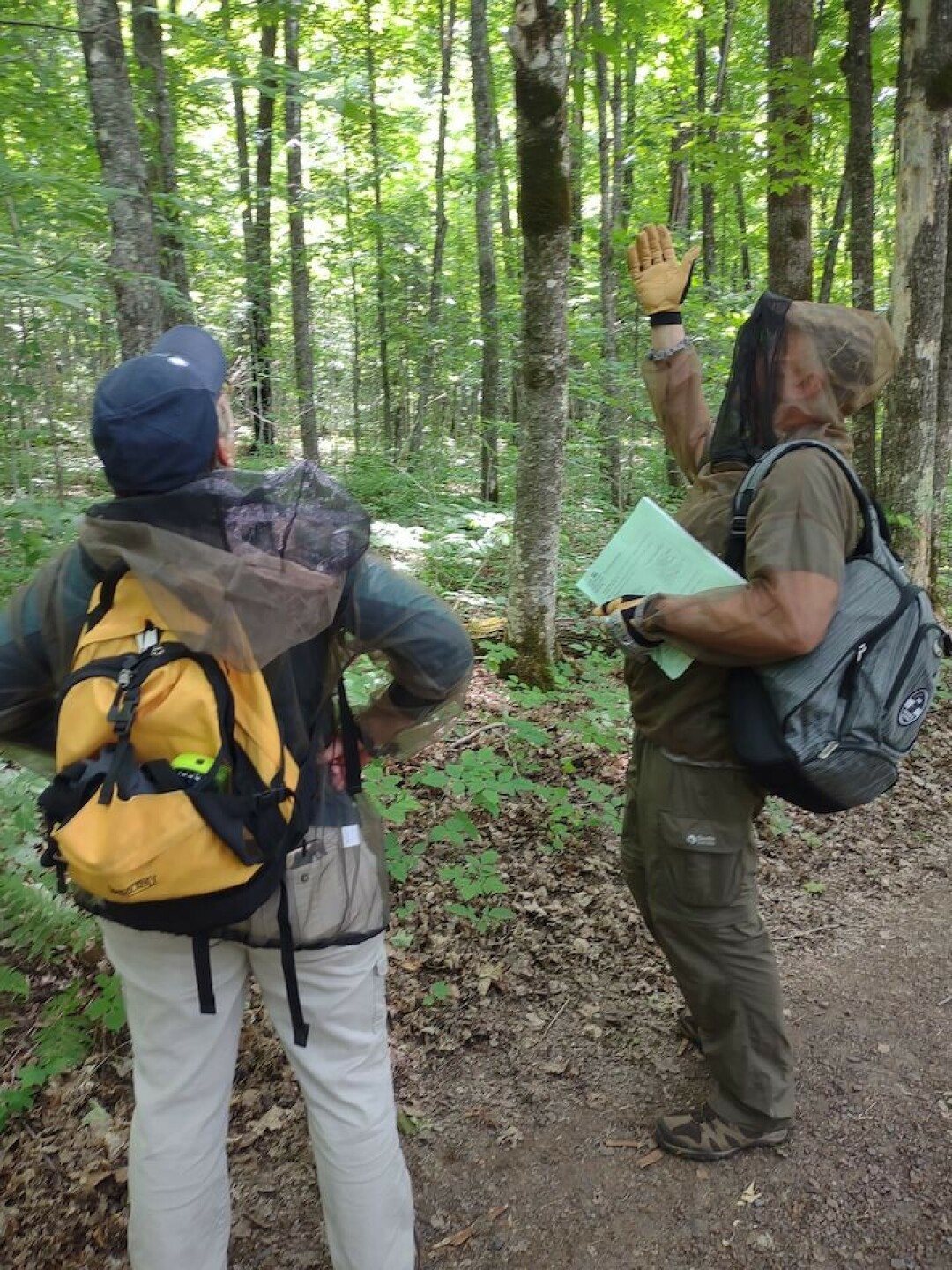News & Articles
Browse all content by date.

The Museum’s new director, Rich Jaworski, became Professor Advanced Regeneration during the Wisconsin Master Naturalist Volunteer Training last week. He’s taking the course to become more familiar with this area and the mission of the Museum. Photo by Emily Stone.
A roll of duct tape bounced along in my backpack, and a permanent marker poked out of my pants pocket as I strode down the trail. A group of 20 Wisconsin Master Naturalist Volunteers-in-Training ambled behind me. We’d had a challenging morning of botany and geology at Morgan Falls in the Chequamegon-Nicolet National Forest. Lunch had revived us, and now it was time for the afternoon activity. Anticipation bubbled.
“During this activity,” I explained, “you will each become a Professor of something in these woods.”
While most of the group opened up their new nature journals to pass the time, I led my first “professor” a little ways down the trail. Maggie and I paused by a big log on the ground, and I asked, “How would you feel about being Professor Coarse Woody Debris?” She was game. I dug out the marker and tape as I explained that foresters use this term to describe fallen dead trees.
We looked at some punky places on the log where fungi were clearly doing their decomposition work, admired the moss growing in the spongy, water-holding material, and talked about death’s roll in the ecosystem. “Ecologists often say that a tree is more alive when it’s dead,” I quipped.
Then, as I handed Maggie a strip of duct tape with her professor name written in black marker, she practiced teaching that same information in her own way. Satisfied with her grasp of the material, I waved at the group of remaining students, beckoning one forward.
“Hello, my name is Professor Coarse Woody Debris,” Maggie introduced herself, and proceeded to teach Craig this little chunk of newly acquired knowledge, ending with a deep thought about how death provides the resources for new life. Then Maggie stayed by her log and invited a new student forward, while I walked Craig down the trail to find a new professor topic.
We stopped by a cluster of little three-leaved plants. (No, not poison ivy!) “Professor Little Jack” I wrote on the duct tape, while I told Craig how Jack-in-the-Pulpit plants can take seven years or more to build up enough energy to finally produce a flower. After expressing his amazement, Craig was ready to teach the next student.
Bit by bit I moved down the trail, finding something interesting for each new “professor” to teach about, while making sure that we were out of conversational earshot but within sight of the professor on either side.
I took advantage of the prolific Jack-in-the-Pulpit flowers let my professors teach about them in easy chunks. After that first patch of just leaves, we found one of their unusual flowers. The outer part looks like a narrow pouch with a graceful rain awning, or an old fashioned church pulpit. Inside that spathe lives the preacher Jack. His part is played by the spadix—the spike that pokes up out of the pulpit structure. At the base of the spadix are tiny flowers, protected from rain by the curving hood of the spathe.
The next professor taught that young Jack-in-the-Pulpits begin by producing only male flowers, because those take less energy. After the leaves churn out enough photosynthesis, older plants eventually gain enough resources to produce female flowers, seeds, and clusters of scarlet fruits.
Down the trail, I left a line of Professors strung out like pearls of wisdom: Professor Virginia Creeper, Professor Habitat, Professor Native Honeysuckle, Professor Buddy Tree, Professor Tip-Up-Mound, and Professor Shade.
When I reached the final student and transformed her into Professor Scratch-and-Sniff at a sweet-smelling yellow birch tree, my job was done. Back in the woods, once Professor Coarse Woody Debris ran out of students, she became one herself, visiting all 19 other professors along the trail. The line folded back on itself.
The activity ended with big smiles and rave reviews when we gathered at the trailhead for our wrap-up. Everyone had loved being a student. They were bursting with the delight of fun facts and chunks of information that they could actually remember and were excited to share. Plus, each Professor was proud of how their talking points had been practiced, polished, and perfected over the many repetitions. The shyer students were relieved that these small bits of public speaking felt very manageable.
Over the years, I’ve found that this Professor Hike activity is very effective at connecting students to nature. What’s been a surprise, especially as I lead it with adults instead of sixth graders, is how wonderful it is at connecting people to each other as they teach and learn.
I chuckled during the wrap-up when a student exclaimed, “Maybe you should bring back the duct tape so we can all be professors again tomorrow!” I chuckled…as I tucked the roll into a handy spot in my backpack.
To find out more about the Wisconsin Master Naturalist Program, visit https://wimasternaturalist.org/ or give Emily a call! Emily’s award-winning second book, Natural Connections: Dreaming of an Elfin Skimmer, is available to purchase at www.cablemuseum.org/books and at your local independent bookstore, too. For more than 50 years, the Cable Natural History Museum has served to connect you to the Northwoods. Our new exhibit: “The Northwoods ROCKS!” is open now! Our Summer Calendar of Events is ready for registration! Follow us on Facebook, Instagram, YouTube, and cablemuseum.org to see what we are up to.
| Tweet |


